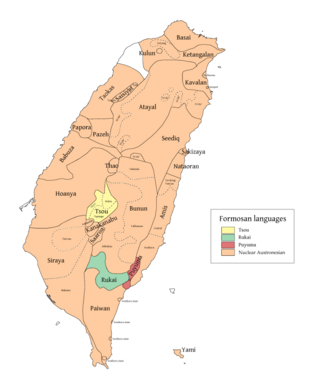Related Research Articles
A fricative is a consonant produced by forcing air through a narrow channel made by placing two articulators close together. These may be the lower lip against the upper teeth, in the case of ; the back of the tongue against the soft palate in the case of German ; or the side of the tongue against the molars, in the case of Welsh. This turbulent airflow is called frication.
In phonetics, a nasal, also called a nasal occlusive or nasal stop in contrast with an oral stop or nasalized consonant, is an occlusive consonant produced with a lowered velum, allowing air to escape freely through the nose. The vast majority of consonants are oral consonants. Examples of nasals in English are, and, in words such as nose, bring and mouth. Nasal occlusives are nearly universal in human languages. There are also other kinds of nasal consonants in some languages.
In linguistics, voicelessness is the property of sounds being pronounced without the larynx vibrating. Phonologically, it is a type of phonation, which contrasts with other states of the larynx, but some object that the word phonation implies voicing and that voicelessness is the lack of phonation.
Uvulars are consonants articulated with the back of the tongue against or near the uvula, that is, further back in the mouth than velar consonants. Uvulars may be stops, fricatives, nasals, trills, or approximants, though the IPA does not provide a separate symbol for the approximant, and the symbol for the voiced fricative is used instead. Uvular affricates can certainly be made but are rare: they occur in some southern High-German dialects, as well as in a few African and Native American languages. Uvular consonants are typically incompatible with advanced tongue root, and they often cause retraction of neighboring vowels.
Rotokas is a North Bougainville language spoken by about 4,320 people on the island of Bougainville, an island located to the east of New Guinea, which is part of Papua New Guinea. According to Allen and Hurd (1963), there are three identified dialects: Central Rotokas, Aita Rotokas, and Pipipaia; with a further dialect spoken in Atsilima (Atsinima) village with an unclear status. Central Rotokas is most notable for its extremely small phonemic inventory and for having perhaps the smallest modern alphabet.

Wyandot is the Iroquoian language traditionally spoken by the people known as Wyandot or Wyandotte, descended from the Tionontati. It is considered a sister to the Wendat language, spoken by descendants of the Huron-Wendat Confederacy. It was last spoken, before its revival, by members located primarily in Oklahoma, United States, and Quebec, Canada. Linguists have traditionally considered Wyandot as a dialect or modern form of Wendat.
In phonetics and phonology, a sonorant or resonant is a speech sound that is produced with continuous, non-turbulent airflow in the vocal tract; these are the manners of articulation that are most often voiced in the world's languages. Vowels are sonorants, as are semivowels like and, nasal consonants like and, and liquid consonants like and. This set of sounds contrasts with the obstruents.
Kobon is a language of Papua New Guinea. It has somewhere around 90–120 verbs.
Prenasalized consonants are phonetic sequences of a nasal and an obstruent that behave phonologically like single consonants. The primary reason for considering them to be single consonants, rather than clusters as in English finger or member, lies in their behaviour; however, there may also be phonetic correlates which distinguish prenasalized consonants from clusters. Because of the additional difficulty in both articulation and timing, prenasalized fricatives and sonorants are not as common as prenasalized stops or affricates, and the presence of the former implies the latter.
Kuman is a language of Chimbu Province, Papua New Guinea. In 1994, it was estimated that 80,000 people spoke Kuman, 10,000 of them monolinguals; in the 2000 census, 115,000 were reported, with few monolinguals. Ethnologue also reported 70,000 second language speakers in 2021.

Western Pantar, sometimes referred to by the name of one of its dialects, Lamma, is a Papuan language spoken in the western part of Pantar island in the Alor archipelago of Indonesia. Western Pantar is spoken widely in the region by about 10,000 speakers. Although speakers often use Malay in political, religious, and educational contexts, Western Pantar remains the first language of children of the region, and is acquired to some extent by immigrants.

Tsou is a divergent Austronesian language spoken by the Tsou people of Taiwan. Tsou is a threatened language; however, this status is uncertain. Its speakers are located in the west-central mountains southeast of the Chiayi/Alishan area in Taiwan.
Amara is an Austronesian language spoken by about 1200 individuals along the northwest coast of West New Britain Province, Papua New Guinea on the island of New Britain. Speakers have close to 100% bilingualism with Bariai, and many also speak Tok Pisin.
Lamogai is an Austronesian language spoken by about 3600 individuals in parts of West New Britain Province, Papua New Guinea on the island of New Britain.
Bukawa is an Austronesian language of Papua New Guinea.
Proto-Tai is the reconstructed proto-language of all the Tai languages, including modern Lao, Shan, Tai Lü, Tai Dam, Ahom, Northern Thai, Standard Thai, Bouyei, and Zhuang. The Proto-Tai language is not directly attested by any surviving texts, but has been reconstructed using the comparative method.
Qaqet, or Baining, is a non-Austronesian language from the Baining family spoken in East New Britain Province on the island of New Britain, Papua New Guinea.
Irarutu, Irahutu, or Kasira, is an Austronesian language of most of the interior of the Bomberai Peninsula of north-western New Guinea in Teluk Bintuni Regency. The name Irarutu comes from the language itself, where ira conjoins with ru to create 'their voice'. When put together with tu, which on its own means 'true', the meaning of the name becomes 'Their true voice' or 'The people's true language'.
References
- ↑ Mouk-Aria at Ethnologue (18th ed., 2015) (subscription required)
- 1 2 Thurston, William R. (1996). Ross, Malcolm D. (ed.). "The Bibling Languages of Northwestern New Britain". Studies in the Languages of New Britain and New Ireland 1: Austronesian Languages of the North New Guinea Cluster in Northwestern New Britain. Pacific Linguistics: Series C. Canberra: Research School of Pacific and Asian Studies, Australian National University. 135: 249–392.